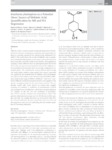Use este identificador para citar ou linkar para este item:
http://www.alice.cnptia.embrapa.br/alice/handle/doc/1066054| Título: | Brachiaria plantaginea as a potential (new) source of shikimic acid: quantification by NIR and PLS regression. |
| Autoria: | COSTA, M. C. A.  MATALLO, M. B.   FERREIRA, M. M. C.   QUEIROZ, S. C. do N. de   ALMEIDA, S. D. B.   FRANCO, D. A. S.   |
| Afiliação: | MARIA CRISTINA ANDREAZZA COSTA, IQ-UNICAMP; MARCUS BARIFOUSE MATALLO, Instituto Biológico; MARCIA MIGUEL CASTRO FERREIRA, IQ-UNICAMP; SONIA CLAUDIA DO N DE QUEIROZ, CNPMA; SIDNEY D B ALMEIDA, Instituto Biológico; DANIEL ANDRADE SIQUEIRA FRANCO, APTA Campinas. |
| Ano de publicação: | 2016 |
| Referência: | Planta Medica Letters, v. 4, p. e81-e86, 2016. |
| Conteúdo: | Abstract: Shikimic acid is a natural organic compound produced in the biochemical pathways of eukaryotic organisms and is generally utilized as a starting material of the antiviral drug Oseltamivir (Tamiflu®). This study shows the results of shikimic acid accumulation in Brachiaria plantaginea, an abundant, grassy plant found in Brazil and other countries in Africa and America, after glyphosate spraying at three different doses. B. plantaginea plants harvested after 6 days of exposure to the herbicide showed that shikimic acid accumulation increased by 345%, on average, compared to unsprayed plants. The combination of near infrared spectroscopy and multivariate analysis using partial least square regression was applied for the quantification of shikimic acid in B. plantaginea. Spectra of 44 samples were obtained using the diffuse reflectance mode in the range of 4000 to 10000 cm-1 with 4 cm-1 resolution. Different mathematical pretreatments were applied to the spectra. As preprocessing, the data were mean-centered. The calibration model with seven factors on twenty-nine samples (training set) exhibited a coefficient of determination =0.9930 and a standard error of calibration =84.05. For external validation (11 samples on the test set), the coefficient of determination =0.9317 and the standard error of prediction =154.91. The percent calibration error range was 1 to 10% for most of the samples and only two samples presented an error greater than 20%. For external validation, the mean prediction error was 10% and the range error ratio was 9.42, indicating that the model is qualified for screening calibration. |
| Thesagro: | Brachiaria plantaginea Gramínea |
| NAL Thesaurus: | Shikimic acid Chemometrics |
| Palavras-chave: | NIR spectroscopy PLS regression |
| Tipo do material: | Artigo de periódico |
| Acesso: | openAccess |
| Aparece nas coleções: | Artigo em periódico indexado (CNPMA)  |
Arquivos associados a este item:
| Arquivo | Descrição | Tamanho | Formato | |
|---|---|---|---|---|
| 2016AA51.pdf | 332,16 kB | Adobe PDF |  Visualizar/Abrir |









